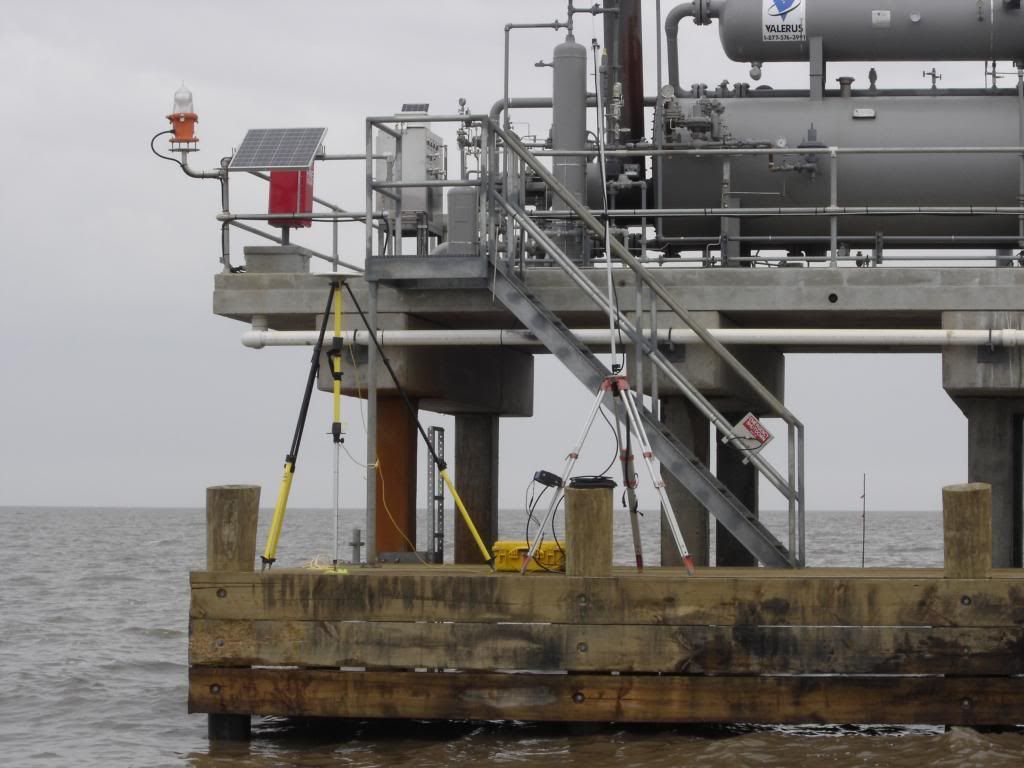I was doing some static GPS work today to bring in some vertical control for a small topo that I am working on.
I found two NGS monuments, and set up a Hiper on one, and a Promark 3 on the other. I went to my site, (about 1.5 miles away or so), and set up my other Hiper and my other Promark 3 on my two traverse points to start my survey from. I left them collecting and grabbed a quick bite to eat.
I went back, and did a little recon, and was making a few phone calls while waiting for the 2 hour observation time to elapse so I could submit to OPUS as a blunder check.
A strong storm blew up, and I quickly picked up the two units on the site, and then ran over to pick up the other two units. I got soaked picking up the second Hiper. It was set up on a tripod in a flowerbed of a church shool. The second Promark 3 was set up on a 2 meter rod on a NGS monument in a private yard. The storm was in full force, and as I pulled into the driveway, I saw the unit had blown over. The receiver was sitting in a small puddle of water, (NOT submerged) but was getting pretty wet. The antenna was about 6 inches or so from the edge of the asphalt driveway.
The unit and antenna appear to be fine, and the unit was still collecting data! I'll have to trim out about 15 minutes or so of the file from the Promark. That is about when the storm blew through. I had checked it about an hour before the storm came up, so it should have some good data.
That is the first time I have ever had a unit blow over. I hope it is the last.
I have had a locus blow over 5-6 times. One got hit by a truck, destroyed the pole and bipod. He jumped a ditch to get it. It is like a hazard of life. I have laid a pipe across the bipod feet, to anchor it. I have driven a 1 foot spike, and anchored it, with a ratchet strap.
Life goes on.
N
Jimmy-
In Ontario we have 4' X 1" x 1" Standard Iron Bars (SIBs) weighing about 15 pounds each.
Three SIBs on the feet of the legs, not touching the ground, will keep most legs from turning over.
Cheers,
Derek
The wind blows constantly in Oklahoma most of the time. You get so used to leaning into the wind, when it stops you might fall over.
There's always two or three of these (sandbags) in the back of our trucks:

Usually found near a pile of disassembled and abandoned type 1s or type 2s off the edge of the road.
They work great to keep the wind from tumpin' my setups and disturbing my lovely and angelical disposition.
Three legged bipods are much better than the 2 legged variety.
Expecting more wind then use a wooden tripod with clamp on the rod.
For setups where I expect trouble I use what I call my quadrapod. I put two bipods on the same rod usually opposite but twice had to put on the same side. A bugger to setup but the extra weight and legs keep it there. you adjust opposite legs in pairs.
Paul in PA
Old motorcycle innertubes make pretty handy sandbags that fit in the truck well.

Why not just use a tripod with sand bags if you are going to all of that trouble?
Someone here mentioned, a while back, that driving a rod in the ground, next to the leg and using a zip tie to hold it to the leg; was a good way to anchor your set up.
I've never tried it, but it sounds like a sound way to keep your set-up, set up.
B-)
Dougie
Here was today's setup. Log Trucks run about 75 MPH down the road within 2 feet of this point.

Here is a close up of the monument.

If they knowck this over, it will do some damage.
So Who Threaded In The Stud ?
Did he pay the $250 fine?
Paul in PA
We took to tying rope around our equipment when working on the water. In south LA some times the best and only place to set up is the oil well platforms/boat docks (suitable land is miles away). We had to do this b/c the storms could blow up out of know where and blow the units down. The 5700 and R7 units were nice b/c the box would float like a bouy while holding the tripod below water (that happened once).

These platforms are not the best for set up, multi path is a pain. But keep in mind what we are surveying.
I was recently involved in a large project which entailed simultaneous long static sessions (some over 3 days) on water level gauge bench marks and NGS monuments along the Texas coast. I used screw-in dog anchors (the ones that look like pigtails, available at pet and department stores) and bungee cords.

I never had a setup blow over or move off plumb, even in the isolated strong storms that spring up around her in the summer. I also used the cheapest "job boxes" I could purchase from a big box home improvement store to house receivers and batteries. A security cable noosed to a nearby power pole or other large object with the other end closed in the box kept the equipment from "walking off" (didn't lose a thing from any of the 170 or so setups). The setup shown was noosed under the rail and over a tie on a nearby railroad track with a second cable secured to the tripod with a padlock.




